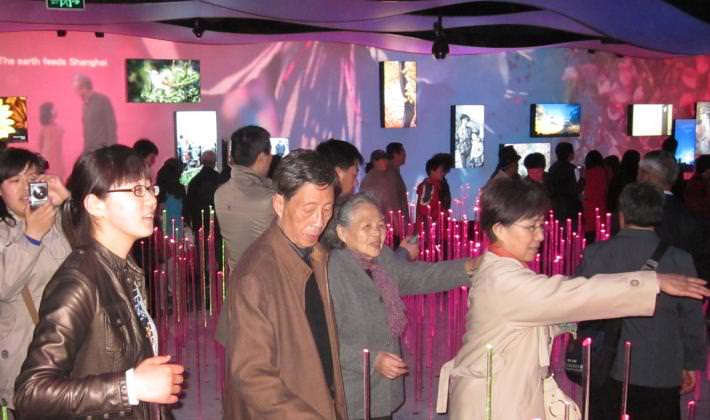Top 10 Takeaways from the 2010 World Expo in Shanghai
Posted June 3, 2010

For the last few years I have had the opportunity to participate in the design of the Shanghai Corporate Pavilion for the 2010 World Expo. Along with our team of partners, I witnessed the transformation of the Pavilion’s site from an empty lot, to a busy construction zone, to the stunning cube of light that it is today. It has been incredibly rewarding to see it completed, and to watch thousands of visitors carrying our design forward as a participatory experience.
I have also had the opportunity to visit more than 20 other pavilions at the Expo. Some are amazing experiences and others are, well, not as engaging. From my perspectives as both a designer and a visiting tourist, the most successful pavilion experiences had many of the same characteristics of design excellence. Here are my top ten:
- Experiences built around a strong core narrative – Pavilions that featured immersive spaces with themes and stories told through film and video often drew me in and sustained my interest more than those without a compelling story. Pavilions that had a lot of different or disconnected elements were less successful.
- Queue comfort! – Waiting in long lines is inevitable at the Expo, but the best pavilions offered organized and thoughtful queues to help visitors stay comfortable and engaged. Pavilions like the UAE and The Shanghai Corporate Pavilion gave visitors a place to sit, shade and mist to beat the heat, and something to do while they waited. Our design for the Shanghai Corporate Pavilion also includes a very effective reservation system which ensures that no one waits more than 30 minutes – a relatively short wait compared to many other pavilions that keep you in line for 2-4 hours.
- Show visitors how to engage with the experience – Urbania is a Pavilion that uses the first room to show visitors what they should be looking for along their journey through the pavilion. This made me feel like I was an active part of the story that was unfoldiong, and I was more interested in what I would discover around the next corner. Similarly, the Shanghai Corporate Pavilion uses the queue as a place to show the visitors how they can interact with the building. This makes it possible for the visitor to understand what’s coming and helps them get comfortable with exploring the pavilion’s story.
- Reveal and surprise – Most visitors want to be surprised, they want to discover and say “whoa!” with the rest of the crowd. If the entire experience is revealed as soon as they walk in, visitors lose intrest. It’s better to let the experience unfold to keep the visitors engaged.
- Photo ops make the memories – People spend a lot of time exploring the Expo through the LCD viewfinder of their cameras. Pavilions like those from Germany and Belgium even had specific places for photo ops, which visitors swarm to! The photos they take are what end up posted across the Internet from their Expo experience for millions of others to see.
- Simple interactive moments keep visitors engaged – Visitors spend most of their time waiting in lines, strolling and and looking atround. The pavilions that offer the visitor a chance to touch, jump, wave, throw, clap, and make something fun happen, really stand out.
- Design consistency – Pavilions with a consistent or unified theme, and a strong look and feel, leave a bigger impression. Many country pavilions try to show too many bits and pieces of culture, history and geography which only dilutes the impact of the narrative they want to communicate.
- Keep it personal with ushers and docents – Nothing beats person-to-person interaction. Ushers and docents help the visitors know where to go, and answer their many questions. The USA and German Pavilions both had ushers who spoke Chinese. They impressed the crowd with their fluency, and their playfulness really made visitors feel welcome. At the Shanghai Corporate Pavilion, our ushers helped the crowd interact with the experience, setting the pace of their stroll, and helped groups work together to make parts of the experience come to life. Pavilions that employed a live performer also stood out among all the digital characters found in most Pavilions.
- Design for all of the senses – The experiences of the best pavilions worked together in very holistic ways to create environments that activated multiple senses. For example, sound often gets the short end of a design and many pavilion structures are acoustically challenged. Urbania, on the other hand, stood out for its sound design. Lighting design is also vital to reveal the beautiful structures and visual moments of each pavilion. And don’t forget about scent! No one likes to walk into a beautiful space that smells like rubber flooring or graphic adhesives.
- Remember the outside as well as the inside – Many of the pavilions, like the UK Pavilion, the Shanghai Corporate Pavilion, and the Spanish Pavilion looked striking from the exterior which acted as an attraction for the visitor. The best extended the sensory experience of the building into the visitor experience. On the other hand, pavilions with striking exteriors, but with interiors that seemed disconnected the rest of the building, were less effective.


Join The Conversation